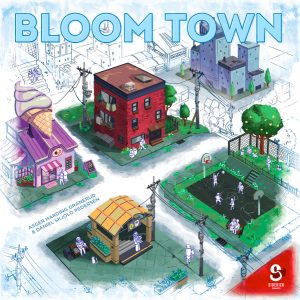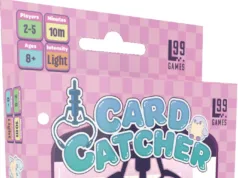 City building is among the most common themes for board gaming and, for whatever reason, doesn’t seem to get the hate we reserve for zombies, generic fantasy, or trading goods for victory points. Obviously city building and tile-laying go together like peanut butter and jelly. In recent years we’ve had hits like Quadropolis, Suburbia, Welcome to Centerville, and countless others.
City building is among the most common themes for board gaming and, for whatever reason, doesn’t seem to get the hate we reserve for zombies, generic fantasy, or trading goods for victory points. Obviously city building and tile-laying go together like peanut butter and jelly. In recent years we’ve had hits like Quadropolis, Suburbia, Welcome to Centerville, and countless others.
Today we are looking at Bloom Town, a lighter take on mashing of this theme and mechanisms. You and up to 3 other of your favorite gamers can put your suburb planning to the test.
Gameplay Overview:
Bloom Town really boils the city building genre into it’s most basic parts. You start with two building tiles and each turn you will place one, score some points, and draw a replacement. There are five different types of buildings, all which score slightly differently:
- Houses score for unique adjacent building types.
- Commercial buildings score for connected commercial buildings in the same row or column.
- Subways score for diagonally adjacent subways.
- Parks give points for being connected to other parks.
- Shops want to be adjacent to two building types (there are different shops for each pair of other building types).

After you’ve placed your tile you don’t necessarily get to just pick the replacement tile of your choice. Your city board has five different symbols that also appear in the common market where the buildings are drawn from. Whichever symbol you cover when placing a building matches the building you must draw.
Within the building market, there are also ten community tiles that correspond to each type of building (2 for each type). If the second community tile of a given type is ever drawn, the type of building will trigger an additional scoring.
When two of the five building stacks are depleted (or three in a 2-player game) the game ends after the round is complete. Players will have two tiles left in their hand and choose one of those tiles as the type of building they want to individually score again. Then the player with the most points is crowned the winner.

Game Experience:
The thing with city-building games is that they really can range pretty widely in complexity. Bloom Town might be the lightest take I can remember. It feels a bit like Carcassonne with it’s “play a tile, draw a tile” approach to laying out your own little town.
While it’s possible that Bloom Town is too light for many gamers, it excels as a family weight game. The artwork and theme are instantly appealing and you can explain the game to a non-gamer in less than 10 minutes. But it manages to do so without making it a complete bore of a game that doesn’t give the players anything to think about.

Every tile placement has at least two things to consider. Obviously, you want to place your tile in a way that maximizes your points. However, where you place the tile in your city also determines the tile you must draw to replenish your supply. Often you will have to consider placing tiles in a way that isn’t necessarily point-maximizing in order to get the tile from the market you want for future turns. There are also some placed on your board that, when a building is played to them, allow you to either double the score for that building or take an additional turn. Timing those well can be imperative to your success.
You even have to consider what building tile you want to save to re-score at the end. If you have a lot of subway tiles, for instance, you may want to acquire another one so you can get 2 additional points per subway at the end of the game. But you can always place it in your city and hope you will find another before the game ends. It’s a bit of a press your luck minigame.

It’s not all rainbows over Bloom Town though. The theme is a little loose here. Why subways want to be diagonal from each other or parks want to be three, but never four, connected tiles doesn’t really translate to anything real. It’s mechanically easy to grasp but you don’t really ever feel that your city comes alive in any way.
The community tile scoring also adds an unpleasant amount of randomness to the game. If you go heavy into parks, for instance, but the two park community tiles are never drawn you will miss out on a boatload of points while your opponents who invested in building types that did get to rescore will be pulling quite far ahead. It’s possible it forces a bit more diversification, but to me, often was a punishment or reward that didn’t quite feel earned.
You do have a one-time use power throughout the game that can, among other things, trigger the rescoring of a type of building that hasn’t had both of its tiles revealed. So you aren’t powerless but it still feels bad to have to give up that tile just because you never got a random tile drawn. Considering how quickly the game plays, it’s rarely longer than 30 minutes, the amount of randomness isn’t the end of the world.
Final Thoughts:
Gateway games have their place in most everyone’s collection. You just never know when you need a game to introduce someone to the hobby that hasn’t already conquered Suburbia. And while there are lots of good gateway options, Bloom Town is one of the best with a city-building theme.
The scoring mechanisms can be a bit random. You may have trouble explaining exactly why rows of commercial buildings are good. But nonetheless, in 10 minutes you’ll have everyone up to speed and laying tiles right away. And the gameplay is engaging enough with plenty to think about with very low rules overhead.
Final Score: 3.5 Stars – A good gateway game with a cute city-building veneer.
 Hits:
Hits:
• Simple rules with just enough depth to make decisions interesting.
• Great gateway game with a theme that is nearly universally appealing.
Misses:
• Community scoring is a bit random.
• Scoring is pretty abstracted from the theme.






















